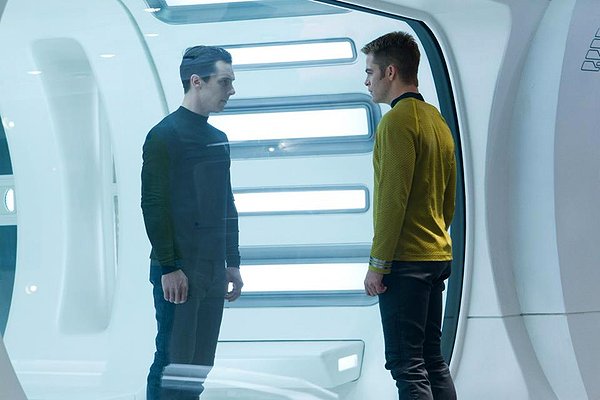Star Trek: Into Darkness
Directed by: J. J. Abrams
Starring: Chris Pine, Zachary Quinto, Benedict Cumberbatch, Zoe Saldana, Simon Pegg, John Cho, Karl Urban
Rated: PG-13 for intense sequences of sci-fi action and violence
There’s a lot to like about the new Star Trek movie, “Star Trek: Into Darkness.” It has a great cast, incredible special effects, and thrilling action. Unfortunately, it also has an incredibly badly-written villain, a storyline that should be fine but somehow falls apart, and it completely fails to embody the underlying themes of the Star Trek canon. If you just want eyecandy, it’s fine, but if you have strong opinions about Star Trek, you should probably either skip this one or bring a flask of your favorite fortifying beverage.
The story relies heavily (a little too heavily, for my taste) on several sudden reveals, so I won’t discuss it in too much depth here other than to say that it revolves around a villainous fellow (Benedict Cumberbatch) who does bad things and then is pursued by the U.S.S. Enterprise and her crew, whom we met in the first film.
This kind of movie lives or dies on the merits of its villain. For example, “The Dark Knight” is a movie with a ludicrous premise, a plot full of holes, and a fair amount of silliness – but the late Heath Ledger was so arresting as the Joker that it was very easy to overlook all that. Unfortunately, “Star Trek: Into Darkness” does not have a villain even close to that good. Cumberbatch’s character is by turns a sympathetic antihero, a scheming psychopath, a crazed terrorist, and a cardboard cutout whose job is to express no emotion while executing amazing fight choreography, depending on what the script calls for. It’s not the actor’s fault – Cumberbatch is very talented and has the physicality the role demands. The script is what falls short.
To make things worse (at the risk of giving away one of the “twists”), this villain is someone from the old Star Trek canon, someone born before the timeline split that gave us this strange new Star Trek world … someone who originally was not white. There are good reasons to be cautious about having a character be both a savage terrorist and a person of color, but “Iron Man 3” handled it incredibly cleverly, so clearly it can be done. Abrams’ decision to whitewash this character and completely change not only his appearance but his characterization is not only nonsensical, it’s cowardly.
Another flaw in the film is its attempt to be both Nolan-level gritty and a Star Trek story. Even at its darkest, Star Trek has always been about the spirit of cooperation, about diplomacy, about hope. You can’t shoehorn that into the kind of bleak, grey-and-chrome cinematic schema that’s all the rage right now. Or rather, if you can, this isn’t how you do it. Abrams’ tacked-on happy ending looks and feels a lot like Star Trek is supposed to, but that’s only the last five minutes.
It’s a shame, because there’s so much good stuff in this movie. Plenty of it doesn’t really belong in a Star Trek piece, but it’s still awesome. There’s a really long, drawn-out (and somewhat brutal) fight atop what appear to be flying transport vehicles. Cumberbatch gets to use his deep voice to very good, creepy effect on several occasions. We get to see the awesome Uhura (Zoe Saldana) speak Klingon, which is really cool. There are heaps of references to the original series for folks to chuckle at. The special effects are gorgeous, although I was disappointed that the bad guy’s ship is really cool-looking and we only get to see it lit very dimly. I wanted a good look at the thing.
But those are all of secondary importance compared to things like character and tone. I didn’t have high expectations for “Star Trek: Into Darkness,” but even those weren’t met except by the surface things that are of secondary importance. If the things of primary importance aren’t there, all the secondary amazingness is empty spectacle.
This is a Star Trek movie with no heart – and a movie with no heart is not Star Trek.
